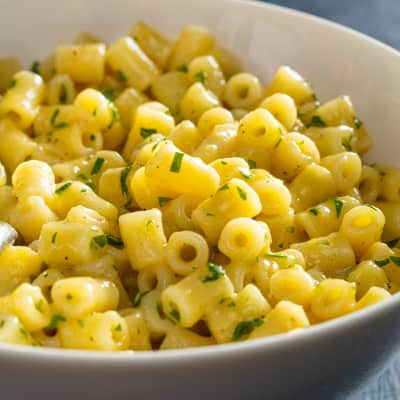There’s lots to love when it comes to pasta cacio e uova (“CAH-chee-oh eh WOE-va”). The cheese and egg pasta, called cas ’e ov in its native Naples, doesn’t dirty many dishes, calls for just a handful of ingredients, and makes its way to the table in a flash. The method is simple: Cooked and drained pasta is returned to the pot and tossed with a garlic-infused fat, such as lard, olive oil, or butter. The magic happens when a mixture of Pecorino Romano, Parmesan, and beaten eggs is poured into the pot—as the egg, cheese, and still-hot pasta are stirred together, the cheese melts, the egg cooks, and a smooth and glossy sauce forms to complete the dish.
Decadent, Cheesy Pasta in a Flash
Published Nov. 30, 2021.

With such a straightforward cooking method, the keys to success lay in ingredient selection and proportions. Choosing a pasta was simple—I’d stick with the traditional choice of tubetti, a tubular shape that’s about twice as long as ditalini—but I had a few options when it came to choosing a fat. Lard seemed to be the most traditional choice, but in the past I had found that most lards tasted plain, so I ruled it out, doubting it would bring much flavor to the dish. A test using butter demonstrated that it got lost amid the cheese and egg, so I settled on toasting a couple garlic cloves in olive oil, which lent the dish a subtle complexity.
With that, I thought I was ready to move on to the rest of my ingredient selection—but then a chat about the dish with Italian food historian Francine Segan stopped me in my tracks. “Lard!” Segan enthused. “Somehow in English the word just doesn’t sound as delicious as it does in Italian. ‘Strutto’—so musical, it melts in your mouth.” With a description like that, how could I not try swapping in lard at least once? And from the first bite of that batch, my mind was made up. The cacio e uova made with lard not only tasted fuller and richer, the cheese flavor heightened, but also felt lighter and cleaner on the palate.
The Curdle Hurdle
Cacio e uova’s sauce seems straightforward—mix beaten eggs and cheese with lard, hot pasta, and some of its cooking water—yet the mixture can turn out grainy and curdled if it overheats. To keep our sauce from scrambling, we mix the sauce and pasta together off the heat, melting the cheese and bringing the eggs up to temperature using only the residual heat in the pasta and the saucepan. The result? Tubetti cradled in a velvety, ultrasmooth sauce.
Next, it was on to the sauce. I liked the flavor and textural balance offered by using 1 ounce each of tangy Pecorino Romano and nutty Parmesan, but I dithered on the eggs—some recipes call for whole eggs, while others add richness through additional yolks. I saw no need to involve extra yolks, because I liked the consistency that resulted from using whole eggs, but how many to use? A side-by-side test made the answer clear: Made with only one egg, the sauce overheated in the final mixing step and became grainy and curdled. With two eggs, on the other hand, the residual heat contained in the pasta and the pot could only melt the cheese and cook the eggs, leaving the sauce silky-smooth.
With the sauce worked out, there was just one small tweak left to make. I had been cooking the tubetti until it was al dente but found that the finished pasta was slightly too chewy. I realized that this is because most al dente pasta is tossed with very hot sauce and the pasta cooking water, which helps the pasta cook just a little more so that it’s the perfect firmness when it reaches the table. The tubetti in this dish, however, doesn’t see much pasta cooking water or heat, so to make sure that it would be tender at the table, I had to cook it just past al dente.

Sign up for the Cook's Insider newsletter
The latest recipes, tips, and tricks, plus behind-the-scenes stories from the Cook's Illustrated team.

